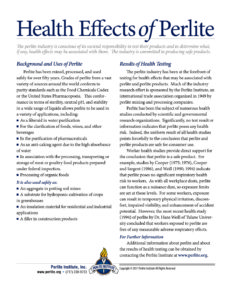Health Effects of Perlite
The perlite industry is conscious of its societal responsibility to test their products and to determine what, if any, health effects may be associated with them. The industry is committed to producing safe products.
BACKGROUND AND USES OF PERLITE
Perlite has been mined, processed, and used safely for over fifty years. Grades of perlite from a vast variety of sources around the world conform to purity standards such as the Food Chemicals Codex or the United States Pharmacopoeia. This conformance in terms of sterility, neutral pH and stability in a wide range of liquids allows perlite to be used in a variety of applications, including:
- As a filter aid in water purification
- For the clarification of foods, wines and other beverages
- In the purification of pharmaceuticals
- As an anti-caking agent due to the high absorbance of water
It is also used safely as:
- An insulation material for residential and industrial applications
- A filler in construction products
RESULTS OF HEALTH TESTING
The perlite industry has been at the forefront of testing for health effects that may be associated with perlite and perlite products. Much of the industry research effort is sponsored by the Perlite Institute, an international trade association organized in 1949 by perlite mining and processing companies.
Perlite has been the subject of numerous health studies conducted by scientific and governmental research organizations. Significantly, no test result or information indicates that perlite poses any health risk. Indeed, the uniform result of all health studies points forcefully to the conclusion that perlite and perlite products are safe for consumer use.
Worker health studies provide direct support for the conclusion that perlite is a safe product. For example, studies by Cooper (1975; 1976), Cooper and Sargent (1986), and Weill (1990; 1994) indicate that perlite poses no significant respiratory health risk to workers. As with all workplace dusts, perlite can function as a nuisance dust, so exposure limits are set at those levels. For some workers, exposure can result in temporary physical irrigation, discomfort, impaired visibility and enhancement of accident potential. However, the most recent health study (1994) of perlite by Dr. Hans Weill of Tulane University concluded that workers exposed to perlite are free of any measurable adverse respiratory effects.

